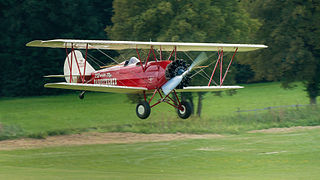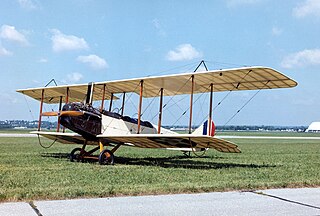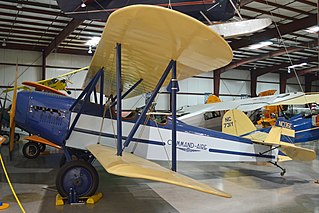
The Curtiss JN "Jenny" was a series of biplanes built by the Curtiss Aeroplane Company of Hammondsport, New York, later the Curtiss Aeroplane and Motor Company. Although the Curtiss JN series was originally produced as a training aircraft for the US Army, the "Jenny" continued after World War I as a civil aircraft, as it became the "backbone of American postwar [civil] aviation".

The Curtiss OX-5 was an early V-8 American liquid-cooled aircraft engine built by Curtiss. It was the first American-designed aircraft engine to enter mass production, although it was considered obsolete when it did so in 1917. It nevertheless found widespread use on a number of aircraft, perhaps the most famous being the JN-4 "Jenny". Some 12,600 units were built through early 1919. The wide availability of the engine in the surplus market made it common until the 1930s, although it was considered unreliable for most of its service life.

The Pratt & Whitney R-4360 Wasp Major is an American 28-cylinder four-row radial piston aircraft engine designed and built during World War II. At 4,362.5 cu in (71.489 L) the largest-displacement aviation piston engine to be mass-produced in the United States, and at 4,300 hp (3,200 kW) the most powerful. It was the last of the Pratt & Whitney Wasp family, and the culmination of its maker's piston engine technology. The war was over before it could power airplanes into combat. It powered many of the last generation of large piston-engined aircraft before turbojets, but was supplanted by equivalent horsepower turboprops. Its main rival was the twin-row, 18-cylinder, nearly 3,350 cu in (54.9 l) displacement, up to 3,700 hp (2,800 kW) Wright R-3350 Duplex-Cyclone, first run some seven years earlier.

The Curtiss Robin, introduced in 1928, was a high-wing monoplane built by the Curtiss-Robertson Airplane Manufacturing Company. The J-1 version was flown by Wrongway Corrigan who crossed the Atlantic after being refused permission.
The 1911 Curtiss Model D was an early United States pusher aircraft with the engine and propeller behind the pilot's seat. It was among the first aircraft in the world to be built in any quantity, during an era of trial-and-error development and equally important parallel technical development in internal combustion engine technologies.

The Naval Aircraft Factory TS-1 was an early biplane fighter aircraft of the United States Navy, serving from 1922 to 1929.

The twin-engine F5L was one of the Felixstowe F series of flying boats developed by John Cyril Porte at the Seaplane Experimental Station, Felixstowe, England, during the First World War for production in America.

The Curtiss Model N was a military trainer used primarily by the United States Navy during World War I.

The Aeromarine 40F was an American two-seat flying-boat training aircraft produced for the US Navy and built by the Aeromarine Plane and Motor Company of Keyport, New Jersey. Fifty out of an original order for 200 were delivered before the end of World War I, with the remainder cancelled due to the armistice.

The Wright R-760 Whirlwind was a series of seven-cylinder air-cooled radial aircraft engines built by the Wright Aeronautical division of Curtiss-Wright. These engines had a displacement of 756 in³ (12.4 L) and power ratings of 225-350 hp (168-261 kW).

The Travel Air 2000/3000/4000 (originally, the Model A, Model B and Model BH were open-cockpit biplane aircraft produced in the United States in the late 1920s by the Travel Air Manufacturing Company. During the period from 1924–1929, Travel Air produced more aircraft than any other American manufacturer, including over 1,000 biplanes. While an exact number is almost impossible to ascertain due to the number of conversions and rebuilds, some estimates for Travel Air as a whole range from 1,200 to nearly 2,000 aircraft.

The Standard J is a two-seat basic trainer two-bay biplane produced in the United States from 1916 to 1918, powered by a four-cylinder inline Hall-Scott A-7a engine. It was constructed from wood with wire bracing and fabric covering. The J-1 was built as a stopgap to supplement the Curtiss JN-4 in production.

The Wright R-790 Whirlwind was a series of nine-cylinder air-cooled radial aircraft engines built by Wright Aeronautical Corporation, with a total displacement of about 790 cubic inches (12.9 L) and around 200 horsepower (150 kW). These engines were the earliest members of the Wright Whirlwind engine family.

The Lincoln-Page PT was an American open-cockpit two-seat single-bay biplane trainer aircraft produced from 1929 to 1931.

The Waco 10/GXE/Waco O series was a range of three-seat open-cockpit biplanes built by the Advance Aircraft Company, later the Waco Aircraft Company.

The Waco 9 is an American-built three-seat biplane design that first flew in 1925.

The Renault 80 hp, or Type WS in British service, was a V-8 aero engine that first ran in 1914. The engine was manufactured in Britain by Renault Limited of West Brompton, London between August 1914 and December 1918, seven other companies, including Rolls-Royce and Brazil Straker, also produced the engine. The Renault V-8 engines were noted as inefficient but reliable, the inefficiency being mainly due to the excessively rich fuel/air mixture used to assist cooling.

The Curtiss Oriole was an American three-seat general-purpose biplane.

The Curtiss Autoplane, invented by Glenn Curtiss in 1917, is widely considered the first attempt to build a roadable aircraft. Although the vehicle was capable of lifting off the ground, it never achieved full flight.

The Command-Aire 3C3 and similar 4C3 and 5C3 are American three-seat open cockpit utility, training and touring biplanes developed by Command-Aire in the late 1920s and early 1930s.



















